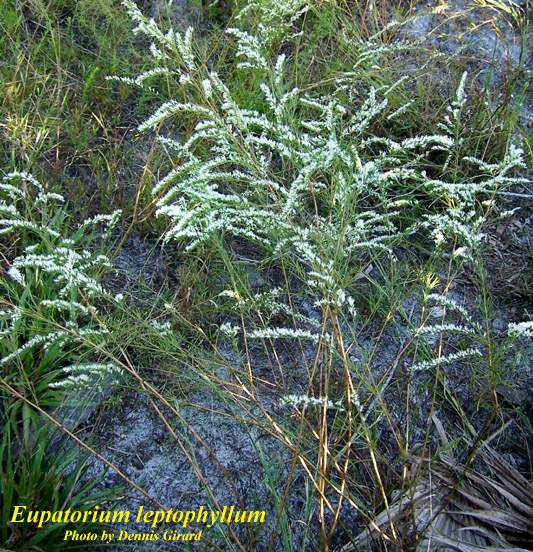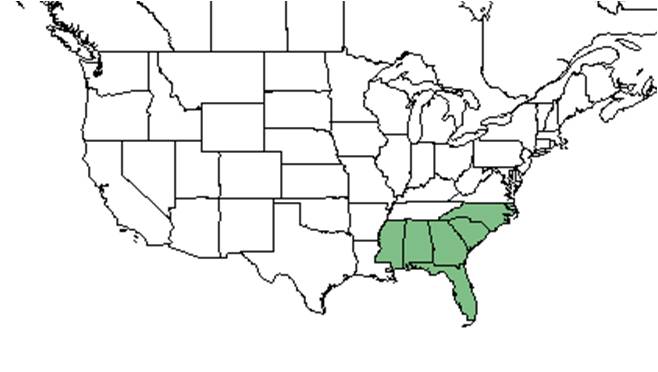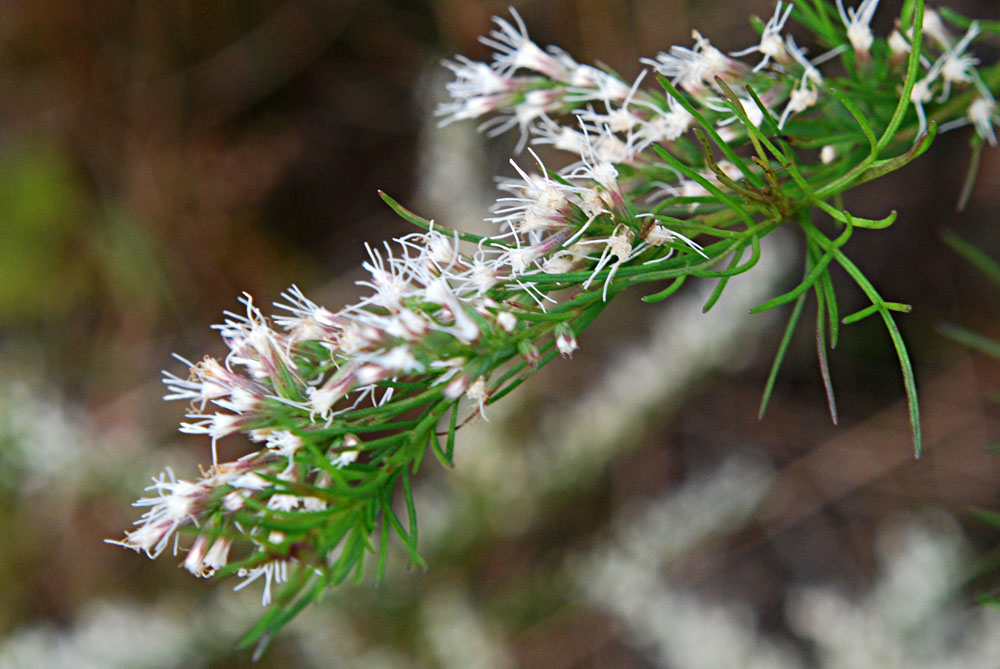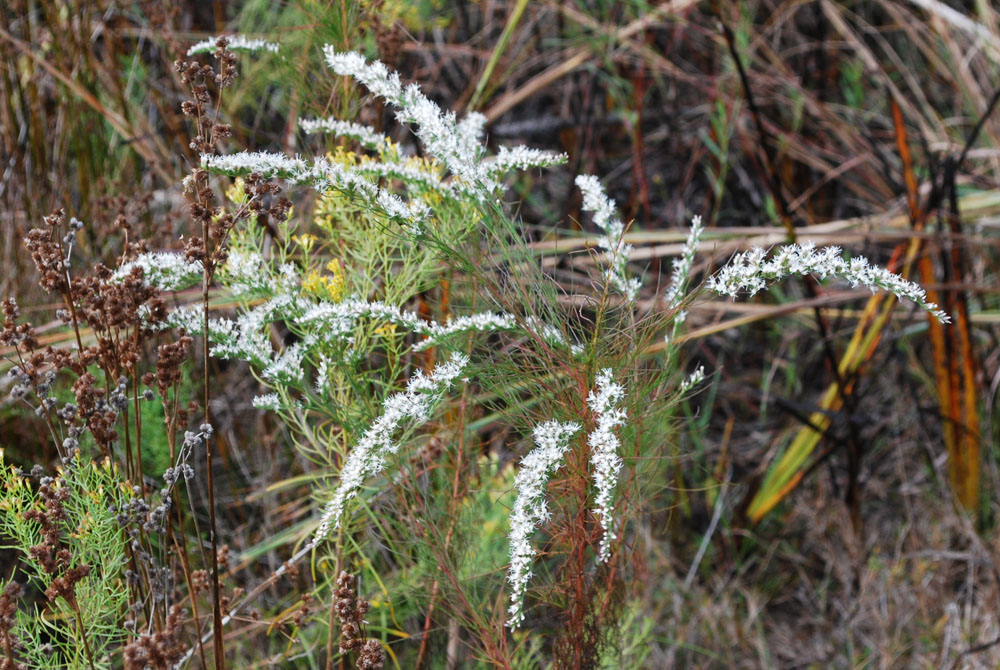Difference between revisions of "Eupatorium leptophyllum"
Emmazeitler (talk | contribs) (→Taxonomic notes) |
|||
| Line 35: | Line 35: | ||
==Ecology== | ==Ecology== | ||
===Habitat=== <!--Natural communities, human disturbed habitats, topography, hydrology, soils, light, fire regime requirements for removal of competition, etc.--> | ===Habitat=== <!--Natural communities, human disturbed habitats, topography, hydrology, soils, light, fire regime requirements for removal of competition, etc.--> | ||
| − | |||
| − | |||
| − | Associated species | + | ''E. leptophyllum'' has been found in sandy-peaty soils, the underside of pond-cypress stands, lake bottoms, broad and marshy shorelines, flatwood ponds, and pine and oak forests. It is also found in disturbed areas including wet roadside depressions, damaged slash pine forest, artificial ponds, and weedy fields. Associated species: ''Iva microcephala, Cladium jamaicense, E. capillifolium, E. compositifolium, Andropogon, Eleocharis robbinsii, Fuirena pumila, Habeneria repens, Triadenum virginicum, Ludwigia, Rhynchospora, Xyris. Bidens, Sagittaria, Nuphar, Polygonum pensylvaticum, Hypericum, Ilex myrtifolia, Eupatorium leptophyllum,'' and ''Nyssa biflora.''<ref>Florida State University Robert K. Godfrey Herbarium database. URL: http://herbarium.bio.fsu.edu. Last accessed: May 2021. Collectors: Loran C. Anderson, Wm. G. Atwater, Wilson Baker, H.A. Davis, J.P. Gillespie, R.K. Godfrey, R.D. Houk, C. Jackson, Robert L. Lazor, Holly Maurushat, Sidney McDaniel, Anne Johnson R.E. Perdue, Paul O. Schallert, and Cecil R. Slaughter. States and counties: Florida: Bay, Dade, Dixie, Franklin, Gilchrist, Jackson, Lake, Leon, Madison, Marion, Nassau, Okaloosa, Putnam, Seminole, Suwannee, Taylor, Volusia, Wakulla, Walton, Washington. Georgia: Baker.</ref><ref>Carr, S.C., K.M. Robertson, and R.K. Peet. 2010. A vegetation classification of fire-dependent pinelands of Florida. Castanea 75:153-189.</ref> |
| − | |||
| − | |||
===Phenology=== <!--Timing off flowering, fruiting, seed dispersal, and environmental triggers. Cite PanFlora website if appropriate: http://www.gilnelson.com/PanFlora/ --> | ===Phenology=== <!--Timing off flowering, fruiting, seed dispersal, and environmental triggers. Cite PanFlora website if appropriate: http://www.gilnelson.com/PanFlora/ --> | ||
Revision as of 16:18, 20 May 2021
| Eupatorium leptophyllum | |
|---|---|

| |
| Photo by Dennis Girard, Atlas of Florida Vascular Plants | |
| Scientific classification | |
| Kingdom: | Plantae |
| Division: | Magnoliophyta - Flowering plants |
| Class: | Magnoliopsida - Dicotyledons |
| Order: | Apiales |
| Family: | Apiaceae ⁄ Umbelliferae |
| Genus: | Eupatorium |
| Species: | E. leptophyllum |
| Binomial name | |
| Eupatorium leptophyllum DC. | |

| |
| Natural range of Eupatorium leptophyllum from USDA NRCS Plants Database. | |
Common name: False fennel
Contents
Taxonomic notes
Synonyms: Eupatorium capillifolium var. leptophyllum (A.P. de Candolle) H.E. Ahles.[1]
Varieties: none.[1]
The genus Eupatorium honors a first century Greek king who discovered an antidote to a poison derived from this family.[2]
Description
A description of Eupatorium leptophyllum is provided in The Flora of North America.
It is a short lived perennial with glabrous stems that reaches around 1 to 2 meters tall.[3] The young stems have few hairs and the leaves are finely divided.[4]
Distribution
Ecology
Habitat
E. leptophyllum has been found in sandy-peaty soils, the underside of pond-cypress stands, lake bottoms, broad and marshy shorelines, flatwood ponds, and pine and oak forests. It is also found in disturbed areas including wet roadside depressions, damaged slash pine forest, artificial ponds, and weedy fields. Associated species: Iva microcephala, Cladium jamaicense, E. capillifolium, E. compositifolium, Andropogon, Eleocharis robbinsii, Fuirena pumila, Habeneria repens, Triadenum virginicum, Ludwigia, Rhynchospora, Xyris. Bidens, Sagittaria, Nuphar, Polygonum pensylvaticum, Hypericum, Ilex myrtifolia, Eupatorium leptophyllum, and Nyssa biflora.[5][6]
Phenology
Have been observed flowering from August to November. [7]
Pollination
The following Hymenoptera families and species were observed visiting flowers of Eupatorium leptophyllum at Archbold Biological Station: [8]
Halictidae: Lasioglossum nymphalis, L. placidensis
Conservation and management
Cultivation and restoration
Photo Gallery
Flowers of Eupatorium leptophyllum Photo by Wayne Matchett, SpaceCoastWildflowers.com
Flowers of Eupatorium leptophyllum Photo by Wayne Matchett, SpaceCoastWildflowers.com
References and notes
- ↑ 1.0 1.1 Weakley, A.S. 2015. Flora of the southern and mid-atlantic states. Working Draft of 21 May 2015. University of North Carolina at Chapel Hill, Chapel Hill, North Carolina.
- ↑ [South Carolina Native Plant Society]Accessed: December 11, 2015
- ↑ [[1]]Accessed: December 11, 2015
- ↑ [[2]] Accessed: December 7, 2015
- ↑ Florida State University Robert K. Godfrey Herbarium database. URL: http://herbarium.bio.fsu.edu. Last accessed: May 2021. Collectors: Loran C. Anderson, Wm. G. Atwater, Wilson Baker, H.A. Davis, J.P. Gillespie, R.K. Godfrey, R.D. Houk, C. Jackson, Robert L. Lazor, Holly Maurushat, Sidney McDaniel, Anne Johnson R.E. Perdue, Paul O. Schallert, and Cecil R. Slaughter. States and counties: Florida: Bay, Dade, Dixie, Franklin, Gilchrist, Jackson, Lake, Leon, Madison, Marion, Nassau, Okaloosa, Putnam, Seminole, Suwannee, Taylor, Volusia, Wakulla, Walton, Washington. Georgia: Baker.
- ↑ Carr, S.C., K.M. Robertson, and R.K. Peet. 2010. A vegetation classification of fire-dependent pinelands of Florida. Castanea 75:153-189.
- ↑ Cite error: Invalid
<ref>tag; no text was provided for refs namedFSU Herbarium - ↑ Deyrup, M.A. and N.D. 2015. Database of observations of Hymenoptera visitations to flowers of plants on Archbold Biological Station, Florida, USA.

